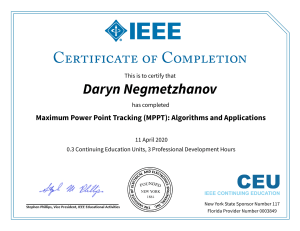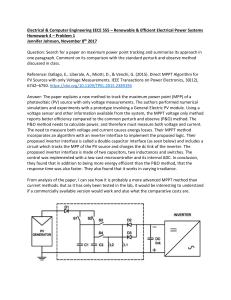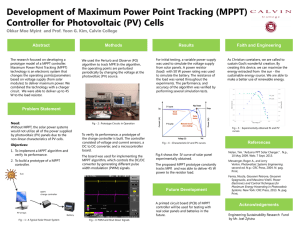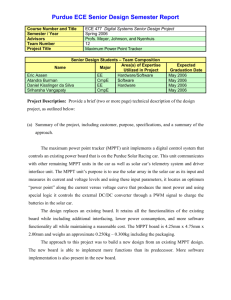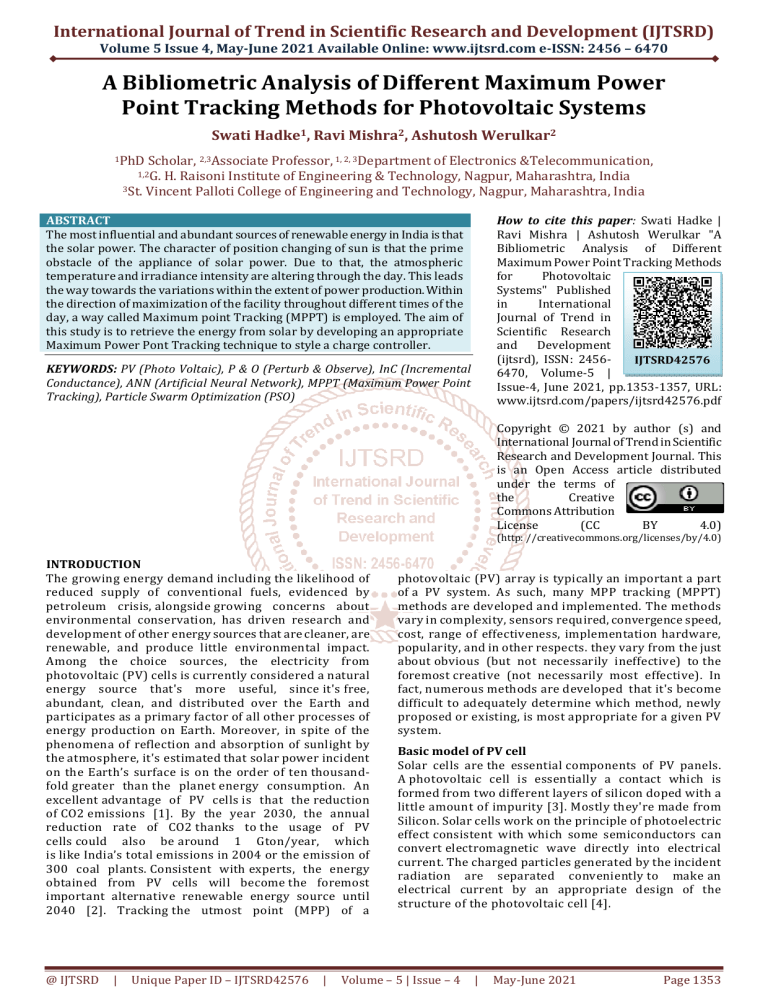
International Journal of Trend in Scientific Research and Development (IJTSRD)
Volume 5 Issue 4, May-June 2021 Available Online: www.ijtsrd.com e-ISSN: 2456 – 6470
A Bibliometric Analysis of Different Maximum Power
Point Tracking Methods for Photovoltaic Systems
Swati Hadke1, Ravi Mishra2, Ashutosh Werulkar2
1PhD
Scholar, 2,3Associate Professor, 1, 2, 3Department of Electronics &Telecommunication,
H. Raisoni Institute of Engineering & Technology, Nagpur, Maharashtra, India
3St. Vincent Palloti College of Engineering and Technology, Nagpur, Maharashtra, India
1,2G.
How to cite this paper: Swati Hadke |
Ravi Mishra | Ashutosh Werulkar "A
Bibliometric Analysis of Different
Maximum Power Point Tracking Methods
for
Photovoltaic
Systems" Published
in
International
Journal of Trend in
Scientific Research
and
Development
(ijtsrd), ISSN: 2456IJTSRD42576
6470, Volume-5 |
Issue-4, June 2021, pp.1353-1357, URL:
www.ijtsrd.com/papers/ijtsrd42576.pdf
ABSTRACT
The most influential and abundant sources of renewable energy in India is that
the solar power. The character of position changing of sun is that the prime
obstacle of the appliance of solar power. Due to that, the atmospheric
temperature and irradiance intensity are altering through the day. This leads
the way towards the variations within the extent of power production. Within
the direction of maximization of the facility throughout different times of the
day, a way called Maximum point Tracking (MPPT) is employed. The aim of
this study is to retrieve the energy from solar by developing an appropriate
Maximum Power Pont Tracking technique to style a charge controller.
KEYWORDS: PV (Photo Voltaic), P & O (Perturb & Observe), InC (Incremental
Conductance), ANN (Artificial Neural Network), MPPT (Maximum Power Point
Tracking), Particle Swarm Optimization (PSO)
Copyright © 2021 by author (s) and
International Journal of Trend in Scientific
Research and Development Journal. This
is an Open Access article distributed
under the terms of
the
Creative
Commons Attribution
License
(CC
BY
4.0)
(http: //creativecommons.org/licenses/by/4.0)
INTRODUCTION
The growing energy demand including the likelihood of
reduced supply of conventional fuels, evidenced by
petroleum crisis, alongside growing concerns about
environmental conservation, has driven research and
development of other energy sources that are cleaner, are
renewable, and produce little environmental impact.
Among the choice sources, the electricity from
photovoltaic (PV) cells is currently considered a natural
energy source that's more useful, since it's free,
abundant, clean, and distributed over the Earth and
participates as a primary factor of all other processes of
energy production on Earth. Moreover, in spite of the
phenomena of reflection and absorption of sunlight by
the atmosphere, it's estimated that solar power incident
on the Earth’s surface is on the order of ten thousandfold greater than the planet energy consumption. An
excellent advantage of PV cells is that the reduction
of CO2 emissions [1]. By the year 2030, the annual
reduction rate of CO2 thanks to the usage of PV
cells could also be around 1 Gton/year, which
is like India’s total emissions in 2004 or the emission of
300 coal plants. Consistent with experts, the energy
obtained from PV cells will become the foremost
important alternative renewable energy source until
2040 [2]. Tracking the utmost point (MPP) of a
@ IJTSRD
|
Unique Paper ID – IJTSRD42576
|
photovoltaic (PV) array is typically an important a part
of a PV system. As such, many MPP tracking (MPPT)
methods are developed and implemented. The methods
vary in complexity, sensors required, convergence speed,
cost, range of effectiveness, implementation hardware,
popularity, and in other respects. they vary from the just
about obvious (but not necessarily ineffective) to the
foremost creative (not necessarily most effective). In
fact, numerous methods are developed that it's become
difficult to adequately determine which method, newly
proposed or existing, is most appropriate for a given PV
system.
Basic model of PV cell
Solar cells are the essential components of PV panels.
A photovoltaic cell is essentially a contact which is
formed from two different layers of silicon doped with a
little amount of impurity [3]. Mostly they're made from
Silicon. Solar cells work on the principle of photoelectric
effect consistent with which some semiconductors can
convert electromagnetic wave directly into electrical
current. The charged particles generated by the incident
radiation are separated conveniently to make an
electrical current by an appropriate design of the
structure of the photovoltaic cell [4].
Volume – 5 | Issue – 4
|
May-June 2021
Page 1353
International Journal of Trend in Scientific Research and Development (IJTSRD) @ www.ijtsrd.com eISSN: 2456-6470
Figure 1: Single diode model of PV cell
In the basic diode model of PV cell, there's a current
source (I) alongside a diode and series resistance (Rs).
The shunt resistance (RSH) in parallel has very high value
and features a negligible effect, hence are often neglected.
The output current from the photovoltaic array isI= Isc – Id
(1)
Id= Io (eqVd/kT - 1)
(2)
The final expression of the current after applying
approximations to (1) & (2) is:
I = ISC - I0 [exp {q (V+IRS)/nkT}-1]
(3)
Where
Io = reverse saturation current of the diode,
Q = electron charge,
Vd = voltage across the diode,
K = Boltzmann constant (1.38 * 10-19 J/K)
T= junction temperature in Kelvin (K)
n = diode ideality factor
The point at which maximum output occurs is obtained
by MPPT methods. This is often done by studying the I-V
characteristics curve of the cell. When the voltage and
therefore the current characteristics are multiplied we
get the P-V characteristics as shown in Figure. The
purpose indicated as MPP is that the point at which the
panel power output is maximum [4].
MPPT Requirement
The power at the output obtained from the solar array is
very hooked in to the intensity of obtainable irradiations
from sun. The utmost power developed during a solar
array system, is essentially rely upon: (i) the load
behavior of the entire system, (ii) intensity of sun ray
falls on the panel and (iii) atmospheric temperature at
that place. The elemental idea of MPPT is that to
switch the entire resistance of the circuit seen by the
panel in order that it can generate maximum power
output. So, to get maximum power the MPPT technique
automatically adjusts the load settings of the systems.
MPPT is employed for coitus interrupts the utmost power
from the solar array and convey that extracted power to
the destination load. Dc-dc converter (step up / step
down) operates like an interface in between the load and
therefore the panel, to serve the intention of transmitting
maximum power from the solar array to load [5]. By
altering the duty ratio the impedance of load is
harmonized with the panel impedance to urge maximum
power from the panel. Point of maximum power is
tracked with altering the duty ratio of the facility
electronics converters to manage the voltage at output.
The choice of sort of converter are going to be used for
any purpose is directly depends upon the wants of
voltage output by the load. Adequate research is on
progress during this part to maximize the facility
generation efficiency of the solar PV panel. The main aim
in MPPT is to regulate the duty ratio (D) of the converter
used. within the source side we use a convertor
that's connected to a solar array so as to reinforce the
output voltage and by changing the duty cycle of the
converter appropriately the source impedance are often
matched with the load impedance.
Figure 3: General scheme of a PV with an MPPT
system.
Figure 2: I-V and P-V Characteristics Curve
@ IJTSRD
|
Unique Paper ID – IJTSRD42576
|
DIFFERENT MPPT TECHNIQUES
1. Perturb & Observe
In P and O method, we use just one sensor hence it's easy
to implement. Voltage sensor used senses the PV array
voltage then the value of implementation is a smaller
amount. The time complexity of this algorithm is
extremely less but on reaching very on the brink of the
MPP it keeps on perturbing on both the directions.
But we will set some error limit as perturbations occurs
near MPP. But this method doesn’t consider change in
irradiation level thanks to perturbation and hence
calculates the incorrect MPP. To avoid this problem we
will use incremental conductance method.
Volume – 5 | Issue – 4
|
May-June 2021
Page 1354
International Journal of Trend in Scientific Research and Development (IJTSRD) @ www.ijtsrd.com eISSN: 2456-6470
3. Fractional Open Circuit Voltage
This method uses the approximately linear relationship
between the MPP voltage (VMPP) and therefore the
circuit voltage (VOC), which varies with the irradiance
and temperature.
VMPP ≈ k VOC
(4)
Where, k may be a constant and depends on the array
characteristics and it must be determined for
various levels of irradiance. It’s value varies between
0.71 and 0.78. To live, the system is pack up for brief time
which causes momentarily power loss. This analysis gives
approximate value of VMPP.
4. Fractional Short Circuit Current
It is same as fraction circuit, but here the connection is
between MPP current (IMPP) and short current (ISC) for
varying atmospheric conditions.
IMPP ≈ k’ ISC
Figure 4: Flowchart of P&O method
2. Incremental Conductance
The disadvantage of the perturb and observe method to
trace the height power under fast varying climate is
overcome by IC method. The IC can determine that the
MPPT has reached the MPP and stop perturbing the
operating point. If this condition isn't met, the direction
during which the MPPT operating point must be
perturbed are often calculated using the connection
between dl/dV and –I/V This relationship springs from
the very fact that dP/dV is negative when the MPPT is
to the proper of the MPP and positive when it's to the left
of the MPP. This algorithm has advantages over
P&O therein it can determine when the MPPT has
reached the MPP, where P&O oscillates round the MPP.
Also, incremental conductance can track rapidly
increasing and decreasing irradiance conditions with
higher accuracy than perturb and observe. One
disadvantage of this algorithm is the increased
complexity in comparison to P&O.
(5)
The coefficient of proportionality k’ is obtained
consistent with each PV array. It’s value varies between
0.78 and 0.92. to live ISC, a further switch to power
converter is required to periodically short the PV array.
5. Fuzzy Logic Control
This method can affect imprecise inputs and doesn't need
an accurate mathematical model and may handle
nonlinearity. The symbolic logic control generally use
microcontrollers. The symbolic logic works in three
stages: i) fuzzification, ii) inference system and iii)
defuzzification. Fuzzification is that the process of
remodeling crisp
inputs
into
linguistic
variables supported the degree of membership to certain
sets. Membership functions are wont to associate a grade
to every linguistic term. The amount of membership
functions used depends on the accuracy of the controller,
but it always varies between 5 and 7. In second stage rule
based table is meant supported some rules which
associates the fuzzy output to the fuzzy inputs
supported the facility converter used and on the
knowledge of the user [8]. The last stage of the symbolic
logic control is that the defuzzification. Within the
defuzzification stage the output is converted from a
linguistic variable to crisp once more using membership
functions.
Figure 6: Fuzzy Logic
Figure 5: Flowchart for incremental conductance
method
@ IJTSRD
|
Unique Paper ID – IJTSRD42576
|
Volume – 5 | Issue – 4
|
May-June 2021
Page 1355
International Journal of Trend in Scientific Research and Development (IJTSRD) @ www.ijtsrd.com eISSN: 2456-6470
6. Neural Network
Neural network and fuzzy logic comes under Soft
Computing. The logic of neural network is motivated
by the subtle functionality of human brain where many
billions of interconnected neurons process information in
parallel. The only example of a Neural Network has three
layers called the input layer, hidden layer and output
layer, as shown in Figure
7. Particle Swarm Optimization
This technique is one among the highly potential
technique among various evolutionary algorithms due
to its simple structure, fast computation ability and
straightforward implementation. PSO is predicated on
the behaviour of bird groups and may be a population
based stochastic search method. The PSO algorithm
maintains a swarm (group) of people (called particles),
where each particle represents a candidate solution. Each
particle tries to compete with the success of
neighbouring particles and its own attained success [4].
Thus the position of every particle depends on the
simplest particle during a neighborhood (Pb) and on the
simplest solution (Gb) establish by all the particles within
the complete population.
(6)
Where ∅i represents the step size of velocity component.
is calculated using Eq. (6), where k1 and k2 are the
acceleration coefficients, w is the inertia weight,, r1, r2 lies
between 0 and 1, Pb is the best position of particle i, and Gb is
the best position of the particles in the complete population.
Figure 7: Neural Network
(7)
More complicated NN’s are often built adding more
hidden layers counting on user knowledge. The input
variables are often parameters of the PV array like VOC
and ISC, atmospheric data as irradiation and temperature
or a mixture of those. The output is typically one or more
reference signals just like the duty cycle or the DC-link
reference voltage [8]. The performance of the NN
depends on the functions employed by the hidden
layer and the way well the neural network has been
trained. In Figure the load between the nodes i and j is
labelled as wij. The weights are adjusted within
the training process. For this, data is recorded for a
period of your time in order that the MPP are often
tracked accurately.
The main disadvantage of this MPPT technique is that the
info needed for the training process has got to be
acquired for each PV array and site. Because the
characteristics of the PV array vary counting on the
model and therefore the atmospheric conditions depend
upon the situation. These characteristics also change with
time, therefore the neural network has got to be
periodically trained.
Figure 8: Movement of particles in optimization process
Fig. 8 shows the standard movement of particles within
the optimization process. PSO method works efficiently
for non- uniform irradiance conditions but the initial
position of the particles plays an excellent role within
the convergence of this method. It's been observed that
when the particles reach the MPP, the speed related
to the particles becomes very low or practically zero.
Table 1: Comparison of MPPT techniques according to several parameters
Sr.
No.
1
2
3
4
5
6
7
MPPT
technique
Convergence
speed
Perturb &
observe
Incremental
conductance
Fractional
Voc
Fractional
Isc
Fuzzy logic
control
Neural
network
Particle
Swarm
Optimization
@ IJTSRD
|
Varies
Varies
Analog
Implement
Periodic
Sensed
Efficiency
or
True
-ation
Cost
tuning parameters
(%)
Digital MPPT
complexity
Control
Voltage,
Low
No
Medium
Both
Yes Moderate
Current
Voltage,
Medium
No
Medium
Digital
Yes Moderate
current
Control
Strategy
Stability
Sampling
Not
Stable
Sampling
Stable
Medium
Low
Yes
Voltage
Low
Both
No
Cheap
Indirect
Medium
Medium
Yes
Current
Low
Both
No
Cheap
Indirect
Fast
High
No
Varies
Very High
Digital
Yes
Expensive Probabilistic
Fast
High
No
Varies
Very High
Digital
Yes
Expensive Probabilistic
Fast
Medium
No
Varies
High
Digital
Yes
Expensive Probabilistic
Unique Paper ID – IJTSRD42576
|
Volume – 5 | Issue – 4
|
May-June 2021
Not
Stable
Not
Stable
Very
stable
Very
Stable
Very
Stable
Page 1356
International Journal of Trend in Scientific Research and Development (IJTSRD) @ www.ijtsrd.com eISSN: 2456-6470
Conclusion
Currently, the usage of energy from PV panels is a reality,
and its intensive use will become extremely important find
solutions to energy and environmental problems very
soon. During this context, the used MPPT techniques are the
foremost important to extract the utmost power available
in PV. From a few years researchers and scientists are
performing on renewable energy sources. MPPT is that
the technique for increasing the output efficiency and mainly
used for system and play vital role in electricity
generation. During this study, general classification and
descriptions of the foremost widely used seven MPPT
techniques are analyzed and compared to means the
benefits and disadvantages of varied MPPT methods. This
paper is useful for choosing a MPPT technique depending
upon various constraints as given within the table. In
practice, the foremost widely used techniques are P&O and
IC thanks to their simple structures and low cost. Recently,
the software-based artificial intelligent techniques like FL
and ANN are growing in MPTT applications.
References
[1] A. Ali et al.: Investigation of MPPT Techniques Under
Uniform and Non-Uniform Solar Irradiation
Condition_A Retrospection IEEE Acess (Volume 8,
2020, July 22, 2020) pp. 127368 – 127392
[2]
Y. Chaibi, “Annual performance analysis of different
maximum power point tracking techniques used in
photovoltaic systems”, Springer Open 2019,
https://doi.org/10.1186/s41601-019-0129-1, pp. 110
[3]
Moacyr Aureliano Gomes de Brito et al “Evaluation of
the Main MPPT Techniques for Photovoltaic
Applications Currently”, IEEE Transactions on
Industrial Electronics (Volume: 60, Issue: 3, March
2013), DOI: 10.1109/TIE.2012.2198036, pp. 1156 –
1167,
[4]
[5]
Shweta Pandey1, Prasanta Kumar Jena2, “A Review on
Maximum Power Point Tracking Techniques for
Photovoltaic Systems”, International Research Journal
of Engineering and Technology , (Volume: 04 Issue: 06
| June -2017), e-ISSN: 2395 -0056
Trishan Esram, Patrick L. Chapman, “Comparison of
Photovoltaic Array Maximum Power Point Tracking
Techniques”, IEEE TRANSACTIONS ON ENERGY
CONVERSION, VOL. 22, NO. 2, JUNE 2007, pp. 439 –
449.
@ IJTSRD
|
Unique Paper ID – IJTSRD42576
|
[6]
Hairul Nissah Zainudin, Saad Mekhilef, “Comparison
Study of Maximum Power Point Tracker Techniques
for PV Systems” , 14th International Middle East
Power Systems Conference (MEPCON’10), Cairo
University, Egypt, December 19-21, 2010, Paper ID
278.
[7]
Sanjay Kumar1 et al. “Maximum Power Point Tracking
Schemes for Photovoltaic Systems: A Comprehensive
Review”, International Journal of Advanced Science
and Technology Vol. 29, No. 7, (2020), pp. 12055 –
12067.
[8]
Soumya Shubhra Nag, Suman Mandal, Santanu
Mishra, “Solar PV Based DC Power Supply for Rural
Homes with Analog, Multiplier-less MPPT Controller”,
IEEE, 2017, pp. 2689 – 2694.
[9]
D. P. Hohm, M. E. Ropp,” Comparative Study of
Maximum Power Point Tracking Algorithms Using an
Experimental, Programmable, Maximum Power Point
Tracking Test Bed”, IEEE, 15-22 Sept. 2000,
DOI: 10.1109/PVSC.2000.916230, pp. 1699 – 1702.
[10]
José António Barros Vieira1, Alexandre Manuel
Mota2, “Implementation of a Stand-Alone
Photovoltaic Lighting System with MPPT Battery
Charging and LED Current Control”, 2010 IEEE
International Conference on Control Applications,
Date Added to IEEE Xplore: 28 October 2010,
DOI: 10.1109/CCA.2010.5611257, Print ISSN: 10851992.
[11]
Nicola Femia, Giovanni Spagnuolo, “Optimization of
Perturb and Observe Maximum Power Point Tracking
Method”, IEEE TRANSACTIONS ON POWER
ELECTRONICS, VOL. 20, NO. 4, JULY 2005,
DOI: 10.1109/TPEL.2005.850975, pp. 963 – 973.
[12]
Weiping Zhang et al. , “A Review of Maximum Power
Point Tracking Methods for Photovoltaic System”,
2016 IEEE International Conference on Sustainable
Energy Technologies (ICSET), 14-16 Nov. 2016,
DOI: 10.1109/ICSET.2016.7811787, pp. 230 -234.
[13]
Eftichios Koutroulis, Frede Blaabjerg, “A New
Technique for Tracking the Global Maximum Power
Point of PV Arrays Operating Under Partial-Shading
Conditions”, IEEE JOURNAL OF PHOTOVOLTAICS,
VOL.
2,
NO.
2,
APRIL
2012,
DOI: 10.1109/JPHOTOV.2012.2183578, pp. 184 –
190.
Volume – 5 | Issue – 4
|
May-June 2021
Page 1357

